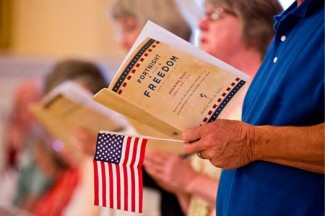
The campaign, now in its second iteration, is the result of what the bishops view as government involvement into what counts, from an IRS perspective, as ministry. The bishops believe that hospitals, schools, and other church-affiliated social service industries are ministries in themselves. The government has a seemingly more narrow view of ministry, and, for tax and regulatory purposes, has deemed such institutions as ancillary to ministry.
What caused the standoff?
Framing the debate
Part of Obamacare, the term preferred by Democrats over the more sterile “health insurance reform,” includes a mandate that employers, through their insurance providers, cover contraception. The Church prohibits the use of contraception. Catholic bishops and a handful of Catholic universities objected, suggesting that as Catholics, they were being coerced into violating their religious beliefs. Those leading the movement adopted, among others, Thomas More as their patron saint. The 16th-century royal advisor accepted death rather than violate his conscience. His feast day was celebrated this week.
Like any group staging a political battle must, the bishops have framed the debate in simple, stark terms. They want Catholics to be able to engage in ministry without government intrusion, interference that they believe coerces them into violating their religious beliefs.
But how the Catholic Church actually interacts with the government is far more complex. Catholic hospitals, for example, receive hundreds of millions of dollars annually from the government, largely in the form of Medicare and Medicaid reimbursements, to carry out their important and essential work. It is estimated that one in six hospital beds in this country is in a Catholic institution. Catholic hospitals, sticking to their teaching that life begins at conception and must end naturally, do not offer abortion, sterilization, or euthanasia services. Some critics contend that because these hospitals don’t offer these procedures, and yet receive so much government funding, that their access to some healthcare services is actually threatened. They see the debate not as the government limiting the freedom of religion, but of religion imposing beliefs, with government aid, on unbelievers.
There are indeed threats to religious liberty, but the issue is far more nuanced than the Fortnight crowd admits. The issues described above shouldn’t be included. Rather, those issues reflect a tension affecting the Catholic Church in this country that involves a polity moving once verboten ideals into the mainstream, and, in its wake, pushing the Catholic Church to the fringe.
Tough questions
Another example cited by the bishops concerns adoption and same-sex marriage. Twelve states and the District of Columbia, where I live, now grant same-sex couples civil marriage licenses. Many of these jurisdictions declared that same-sex couples also possess the right to adopt children. As such, state agencies that place children into adoptive homes are forbidden from discriminating against same-sex couples. Local Catholic Charities agencies, many of which receive large government grants to run their successful adoption programs, faced a dilemma. Do they place children with same-sex couples, which some saw as untenable given the Magisterium’s teaching against homosexuality, or refuse to comply with the new guidelines, thus forgoing the government money and subsequently shuttering their service? In Massachusetts and Washington, D.C., the Church chose the latter. Religious liberty activists raised a red flag. The freedom to practice their faith, which in this case included offering adoption, had been hampered by an overreaching government.
The surge in public support for same-sex marriage demonstrates the problem for the Church. Just a decade ago, a large majority of Americans believed not only that marriage between two members of the same gender should be banned, but that homosexuality itself was immoral. Fast-forward to today. A majority believes in the legalization of same-sex marriage, and even higher numbers have dropped their moral opposition to homosexuality in general. The Catholic Church, of course, teaches otherwise, a now minority viewpoint. So, as laws are passed to catch up to the public’s views on these issues, Catholic institutions find themselves increasingly isolated and facing new realities. There are several questions that Church leaders must confront. What does it mean to operate in a society that no longer embraces our ideals? As laws are passed and norms change, how do we interact with the government? Which money will we accept and which programs are we willing to close as a result of our choices? Are we to engage with a shifted culture and find common ground, or will we retreat and return to a ghetto church?
Of course, protecting threats to religious liberty in this country is essential. They are real. Imagine if we, as a Church, convened Catholic bishops, priests, and religious, along with laity from all walks of life, including scholars, writers, lawyers, people from business and industry, heads of charities and nonprofits, philosophers, historians, artists, students, children, families, Catholics in the pews, and those that have fallen away, to consider how the Church might confront this changed reality. How can the Church contribute in today’s public square? How will we engage our culture? Where can we meet others of good will to achieve the greatest good? Fifty years ago, Pope John XXIII asked the church to open the windows to let in some cleansing air. Today, Pope Francis calls believers and nonbelievers to do good, meeting and knowing one another along the way. A campaign like the one described above would show that we, as Christians, have nothing to fear. We will find ways to live our faith, serving those in need, and embracing all God’s creation. What’s more Catholic than that?